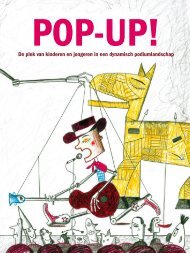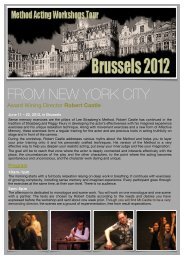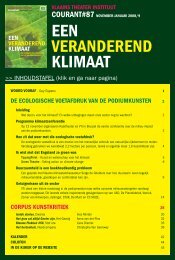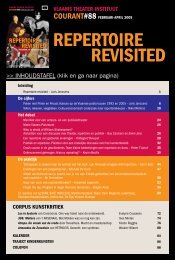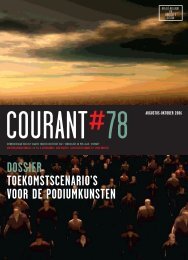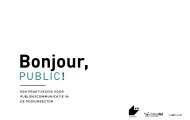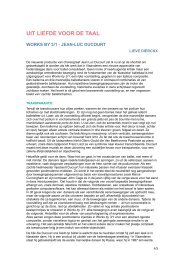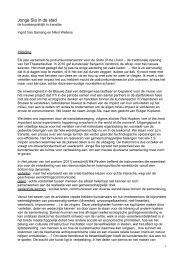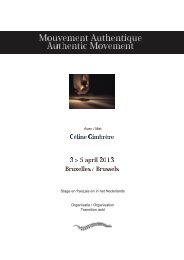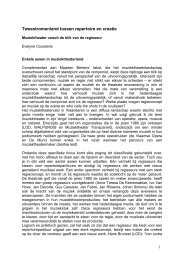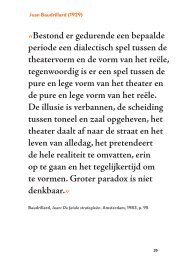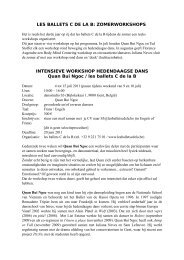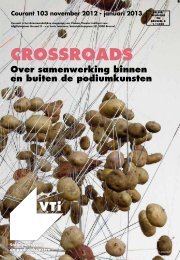You also want an ePaper? Increase the reach of your titles
YUMPU automatically turns print PDFs into web optimized ePapers that Google loves.
josse de pauw<br />
Smith). With a minimum of acting movement, the actors tell us<br />
about the figures in the story or speak through them. Sometimes<br />
they come close to a genuine character, and then shortly afterwards<br />
leave it again. The actors remain above all themselves;<br />
they are speaking bodies who build up the story together and<br />
alternately allow each other to speak. In so doing, the commentator<br />
Willy Thomas uses a microphone and a portable loudspeaker,<br />
while dressing up in carnival hats, false spectacles,<br />
beards and ears. He narrates in an ironic and sarcastic manner;<br />
this tone keeps the deeply serious theme in balance while strangling<br />
any possibility of pamphleteering but at the same time<br />
emphasises the seriousness of the findings. The other actors narrate<br />
in a deliberate, subtle and intimate manner.<br />
The inspiration for the text came both from Van Kraaij’s study<br />
of American history and <strong>De</strong> <strong>Pauw</strong>’s reading of Robert Hughes’<br />
The Fatal Shore. From this they distilled the story of an Irish<br />
smith who emigrated to America in the early 19 th century to enter<br />
the service of the Corps of Discovery that President Jefferson had<br />
commissioned to chart the unexplored Missouri river. There he<br />
witnesses an Indian woman (Sacajaweja) giving birth to the child<br />
of a white Canadian. After the death of the Canadian, the Smith<br />
also fathers a child by her. The first-born is called Pomp, the second<br />
just Kind [Child]. Through the life of these two half-brothers<br />
we experience the history of the exploration of north-west<br />
America and the contact with Indian tribes, the famine in Ireland<br />
and the penal colony in Australia.<br />
The research work that accompanied this writing process is<br />
clear to see in the quotation of historic details and the references<br />
to historical events that are scattered throughout the play.<br />
Although the writing is in the same visual, poetic language as<br />
Ward Comblez, this is a more complex play with broader intentions.<br />
The various voices which, in the monologue, centred on<br />
the narrator, are in Het Kind van de Smid divided into different<br />
figures. In this play, the different voices have become a more<br />
clearly structuring element. History also becomes a separate<br />
voice, which is both informative and creates and epic setting.<br />
Extracts from authentic documents are read out to the audience:<br />
speeches by Indian chiefs, extracts from logbooks, a quotation<br />
from President Thomas Jefferson, etc. become part of the writing,<br />
in their original form. Actual dates and geographic locations<br />
are constantly being given, which makes the real historic frame-<br />
30 / Kritisch Theater Lexicon - 14 e - August 2001<br />
artistic development: de pauw’s way and weg<br />
work a prominent presence. The references in the following passage,<br />
for instance, describing the death of the Indian woman<br />
Sacajaweja (the Smith’s wife and mother of the Child), absorb it<br />
into the epic progress of time, as a detail in the mass white exploration<br />
of North America.<br />
The Smith<br />
Soshone camp, autumn 1812<br />
The Indian woman is ill. The medicine man is busy day and<br />
night. I do not sleep.<br />
Soshone camp, autumn 1812<br />
That old fellow with his rattles is starting to get on my nerves.<br />
This is a white illness.<br />
The Child<br />
It was autumn 1812. We took the Indian woman to Fort<br />
Manuel. The white doctor there would cure her. …<br />
The Smith<br />
Fort Manuel, autumn 1812<br />
Her nails in my arm.<br />
The Child<br />
20 th September, 7 o’clock in the evening, the Indian woman,<br />
our mother, died.<br />
Set against this immense background, the story of these fictional<br />
characters assumes a form. The three characters are narrators:<br />
they have hardly any dialogue with each other but their narrations<br />
build up the story piece by piece. Both Pomp and the Child<br />
tell about themselves in the first person and about each other in<br />
the third person , but they rarely use the dialogue we-form. Just<br />
as in Ward Comblez, the epic preterite is a form of expression in<br />
storytelling. <strong>De</strong>scriptions of nature and human movements<br />
throughout the play slow it down somewhat. Erwin Jans called<br />
this ‘the slow rhythm of observation’ 13 . The images evoked are<br />
highly distilled. The environment is sketched using few but carefully<br />
chosen words. This distances us from what is being told,<br />
and in this lies the poetry of the text.<br />
In Het Kind van de Smid, Josse <strong>De</strong> <strong>Pauw</strong> and Peter Van Kraaij<br />
create the possibility for the individual to sustain himself in an<br />
intersubjective relationship with time by way of a poetic narration.<br />
The two half-brothers metaphorically embody the universal<br />
dialectic between an internalised search for connections in life (as<br />
31 / Kritisch Theater Lexicon - 14 e - August 2001



